
MZ ETZ250 Tuning: More Torque
Fitting a 300 top end and an easy porting modification improve low end power to cure one of the ETZ250’s biggest riding problems. Experienced two-stroke specialist Derek Pickard explains how he got the right results.
We all like the ETZ250. This model MZ is cheap to buy, keeps on going and does a good all-round job. It has only a couple of problems: typical two-stroke bad fuel consumption and disappointing low power below 3000rpm which is regularly an irritant.
While there’s nothing much which can be done to the bad fuel economy, various people have had a few attempts at adding more power lower down in the rev range. One popular mod is to fit a different head and barrel from an earlier model 250, and another is to convert the engine from 250 to 300 with a new top end.
Given that the problem with the ETZ250 is the near absence of low end torque, to get a clear understanding on this I used my two-stroke engineering background to fully measure exactly what is what. This was to identify the problem and hopefully point the way to a solution.
Sun, beach, cafes, palm trees and an MZ. What more could anyone want in a photo? Actually, it’s my local beach near downtown Melbourne, one autumn evening
Pulling apart the top end and measuring the port timing and capacities quickly revealed what was wrong. The stock ETZ250 may have a mild inlet port and transfer facility but the exhaust port is relatively big and high. In fact, the exhaust is so high it is more like the port size found in a mid-1970’s 250 moto-cross competition layout.
Additionally, the all-important exhaust system dimensions not only complements that high port but at the end where a convergent cone should be, MZ has configured their version of a vertical silencing baffle which effects a rev shut-down before 6000rpm. The two combined means the powerband is just 3000 to 5500 or maybe 6000. Incredibly narrow and frequently frustrating.
Clearly MZ wanted to avoid their engines being revved on their ordinary alloy pistons with the then oils and so they went for silence and minimal wear. But the use of modern oils (read: synthetics) and a more appropriate back end to the exhaust with a tapered convergent cone and absorption type muffler would see the engine go on producing power to past 6500. However, modded two-stroke performance exhausts always result in more noise and that is certainly not what I wanted.
For me, I was more than willing to lose a bit of power up top for a torque gain around 2500rpm to make the bike more user-friendly in the city.
As any first year auto engineering design student knows, the best way to gain torque is to add cubes and for my ETZ250 that meant a conversion to incorporate an ETZ300 top end. The bigger head and barrel has to mean a relatively easy additional 20 percent. But that engine’s porting is the same as its smaller brother so the fundamental problem has to remain with sod-all bottom end power.
And as students of the bleeding obvious know, when 20 percent is added to sod-all, you’re still at sod-all.
So the solution had to be to fit a 300 top as well as modifying it for more lower end power. Normally, the proper conversion to correct this high exhaust port has to be the following:-
— Machine 3mm off the base of the barrel (which not only lowers all ports but pokes the piston up into the head). Don’t touch the exhaust port but raise the height of the transfer port tops 3mm (noting that retaining the correct final directional shape is a difficult job).
— Machine the combustion chamber to both accommodate the extra height of the piston at TDC and regain the correct squish clearance as well as the right combustion chamber capacity. I’m assuming the head casting has enough alloy in it to allow this.
— Fit a reed valve to the inlet port to counter its new low position. (Be warned to never lower a barrel that has ANY wear as the rings will then be asked to jump the previous wear ridge which was at the top of the stroke, so causing lack of seal and losing compression. Even slightly worn barrels that are lowered must be rebored.)
— Slightly lengthen the exhaust primary pipe length to complement the shorter exhaust port timing.
— Compensate for the lower inlet port by fitting a reed valve of the right flow rate. Select your reed valve assembly carefully. There are many available from all manner of old Yamahas over the years, but a good one to use gives a total open area when all reed petals are open of at least 10 percent more than the open carb cross section area.
My recommendation is for an old Yamaha IT175 or DT250 six petal valve. Going any bigger and creating more reed valve capacity is as useless as an over-size carb. Remember, the inlet facility has to work as a single size-matched unit with all aspects of carb, reed and port all complementing each other.
And as for how such a large dollop of metal such as a DT250 reed valve assembly is accommodated within a nice inlet shape gives no easy answer. The MZ racer guys have various ways of doing it but all involve lots of work.
— Maybe take advantage of the lower inlet port to slightly enlarge the size of the manifold and port window (raise the top by 3mm) to allow a slightly bigger carb.
The work involved in achieving those six steps is very hard, too hard, so I had to find a simpler way. My decision was to do no more than to reduce what is known as the ‘exhaust lead’ which is the higher position of the exhaust port top height over the transfer ports top height. Put simply, mild engines only have a small amount of exhaust lead whereas high revving engines have much higher exhaust ports before the opening of the transfer ports.
As I didn’t want to spend hours of work with a fine angle grind tool, painstakingly raising the transfers only to risk mis-matching the heights or wrecking the emitting angles, I opted to use the old dodge of filing notches into the top of the piston alongside the transfers. The only problem with this is if too much is taken off then the squish facility can be upset and bad combustion could result.
I opted to remove just under 1.5mm off the top of the piston edges for the transfers circumference dimension. Okay, that delivers no huge reduction in exhaust lead, but at least it was reduced and every bit helps.
The shape of the two small notches filed into the top of the piston is shown with black ink and the worryingly thin 2mm base of the liner means be careful not to drop the modified 300 barrel
When doing this, be careful to file away no more than is strictly needed for smooth shapes around tapered notches. To make it clear where this is done, the piston top in the photo has had the chamfer outlines highlighted by black ink.
(I learnt the big effects from small port changes back in the late 1970s when I was working as a test rider for an American motorcycle magazine and I had criticised the Yamaha IT175DE models for being too peaky. Then the maker released the F model where the barrel was no different than a 1.5mm lower exhaust port height and the bike definitely had a slightly more flexible powerband. A definite difference from so little change proving how two-stroke ports can be fussy things.)
Warning. DON’T even think of trying to reduce the exhaust lead by lowering the height of the exhaust port top with smart build-up of weld across its width. All you’ll probably do is melt the near alloy in the barrel which will leave a cavity that will reduce heat transfer which results in local hot spots and probably wear or seizure.
All fairly easy so far. But there’s another big job ahead. You see, the 250 crankcases have a barrel aperture of only 80mm which is too small for large base spigot of the 300 barrel at 84mm.
So that bottom outside diameter of the larger liner has to be reduced. Most people will say this can be done in a lathe but I think clamping the top of the barrel up against stock jaws in a chuck and just machining into the outside diameter all of 145mm away is asking too much of conventional jaws.
MZ 250s on’t eBay Right Now.
I sez it’s too risky and don’t attempt to do it that way. I had a machinist invert the barrel and clamp it top down to the bed of a mill and then the cutting tool could spin around the outside with complete safety. This way the O.D. was reduced to 79.8mm which for a stock bore 300 means the thinned bottom of the liner is now only around 2mm wall thickness.
Be careful.
And everything else can stay the same: head, exhaust, inlet, ignition and carburettor.
This is one of the frequently misunderstood areas with two-stroke development. Big carbs can mean more top end power if relevant aspects of the engine are altered to suit, but they almost never give more low range torque. Whether or not to fit a bigger carburettor all comes down to if you will use your 300 mostly at 5000rpm.
If so, then go a 32 carb or even a 34mm and enable either to work by carefully enlarging the inlet manifold throughout its length and the port window (the rectangular hole at the bore) height by no more than the dimension of the barrel lowering.
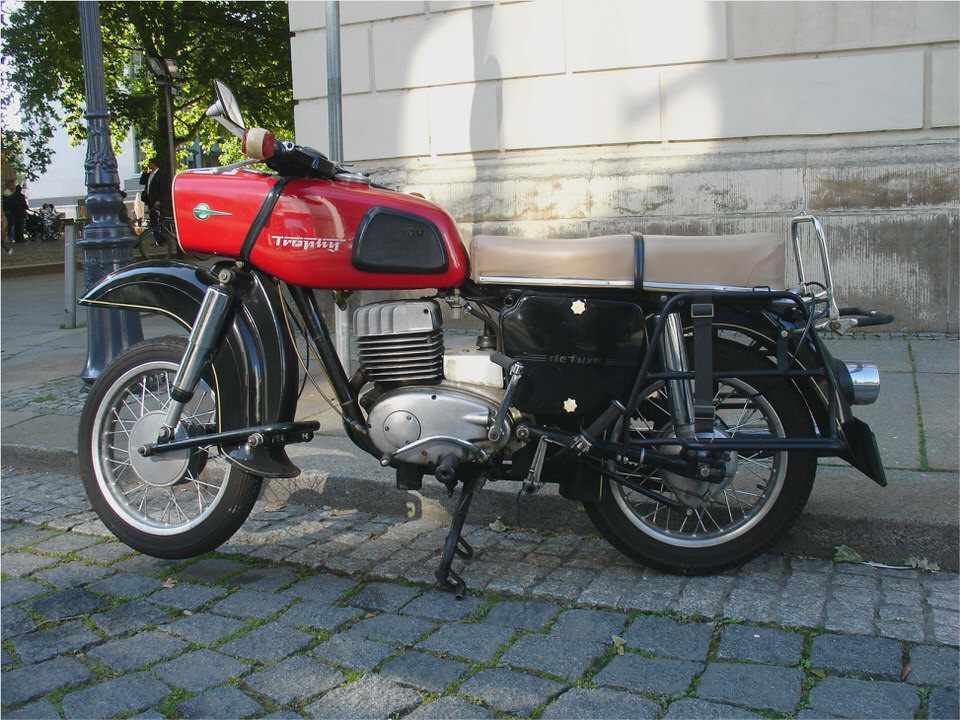
Leave the width alone and don’t remove the unusual protrusion that hangs down from the top of the port window as it aids piston skirt/ring life. And no matter what anyone tells you, exceeding 34mm in carb diameter for a 300 road bike exhaust limited to 6000 is wrong.
Obviously, the squish clearance must be checked on rebuild and I sez go a smite tighter and use 95 octane petrol. That’s because compression like capacity delivers torque.
About the only changes remaining are then to the tuning and that could mean going up a size or two on the main jet. I ride my bike from 2500 to 4500 or 5000rpm max so the original size 30mm carb was retained. Right now I№m using the Amal 2930 Concentric Mk2 and went up one size in the main jet from what I was using when it fuelled the 250.
And that about sums up all what I did.
The one-eyed East Germans couldn’t even keep their politics out of their motorcycles. The MZ tacho doesn’t have a red line at the max since red meant go in the old communist doctrine. So this tacho has a broad red line from 3000 to 6000 which is where the engine works at its most efficient
Which all leads us to the result and the question of was it worth the money and effort. The honest answer is yes and no, depending how the results are judged.
The power characteristic was not totally transformed to take some power away from 6000 and put it closer to 2000rpm. There was only a small shift so yes, some gain resulted. And that improvement along with the overall effect of 20 percent more cubes has made my MZ a bit better to ride, not as much as hoped but definitely along the lines of what I was aiming at.
To put numbers into the equation, whereas before the 250 engine had no useable power below 3000, now it comes on a bit stronger at 2000, a bit stronger again at 2500 and by 2750 the increase can definitely be felt. What this does is provide just enough increase to take a tight turn by leaving the bike in second gear and roll the throttle off and on, instead of shifting down to force the revs up past 3000 in a clumsy jerking action. Pull-away from standstill is also slightly better.
A sidelight is the way the slightly wider torque band that enables me to run the engine slower has allows me to switch to a softer grade spark plug for around town running. That’s gotta prove something.
The big surprise was the motor’s new found reduction in vibes. Clearly the bigger and so slightly heavier piston alters the balance factor set into the crank layout and this manifests itself as removing the irritating tingling-type vibration on an ETZ250 when cruising at 60 or 70mph. Fitting the bigger piston certainly smoothed out my engine.
An unexpected and very welcome improvement.
The other bottom line of money is a more interesting one. You see, by the time I bought a 300 top end in UK, had it mailed to Australia, paid for vapour-blast ultra cleaning, bought new rings, had the barrel honed, rebadged the side covers, paid for the precision machining and threw the whole thing together with new gaskets, the result was a small upgrade which cost near enough what I paid for my ETZ250 originally. Crazy.
But I did get to increase the capacity to the biggest practical size and the bike also now boasts 300 badges.
Interesting Numbers
Going from 250 to 300 cubes is a 20 percent increase which, all things being equal, could give a 20 percent lift in power output. But the factory claims only a 15 percent improvement which is probably down to the fact that the stock 30mm carb is retained presumably for production economy reasons. Increasing the carb size to 32mm should realise more of the mid to top end power potential but it would also do nothing to the lower end torque and certainly take away some fuel mileage.
My fuel economy number is unchanged at 45mpg because I can shift up sooner as the bigger engine pulls a higher gear sooner during acceleration.
A Few Final Tips
Do not go hacking into ports/piston unless you are prepared to be careful and clean out all filings. Stay away from a trick extra transfer port at the rear of the cylinder as that layout is mainly for mid to top end power. Leave the exhaust stock unless you know what you№re doing and never forget that noise and power are not the same thing.
And always ensure the top mechanical condition and fits of a good piston, bore and rings as they are the heart of a good two-stroke at any revs.
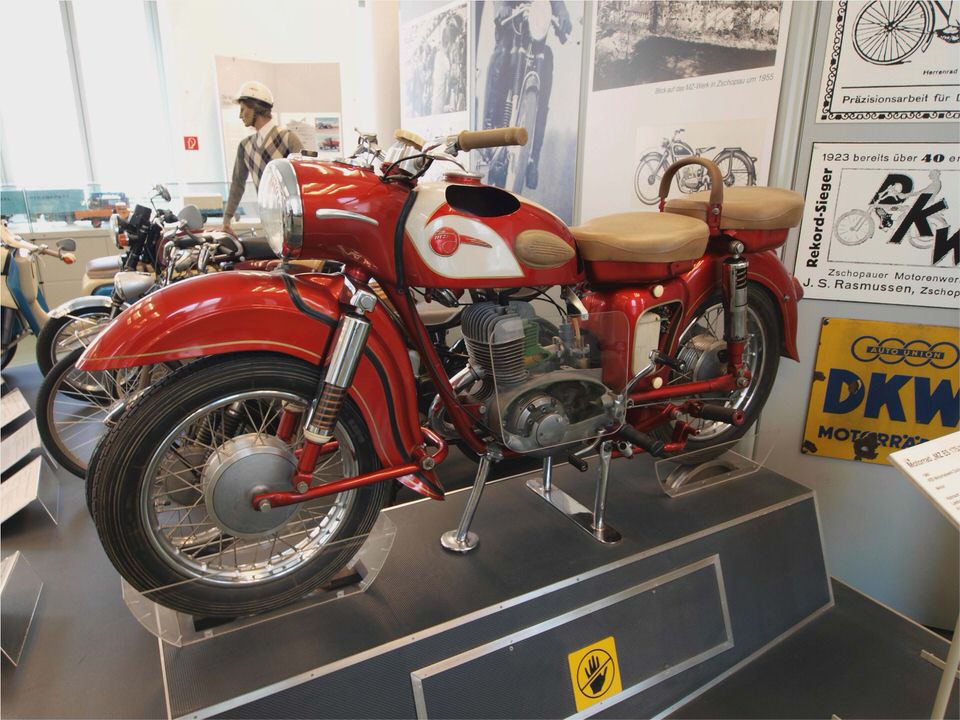

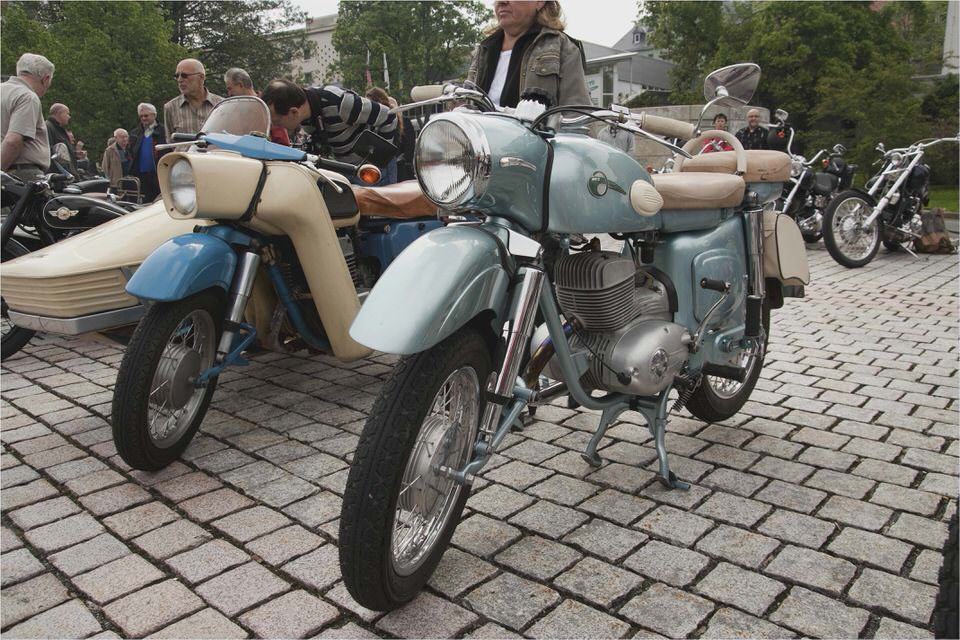
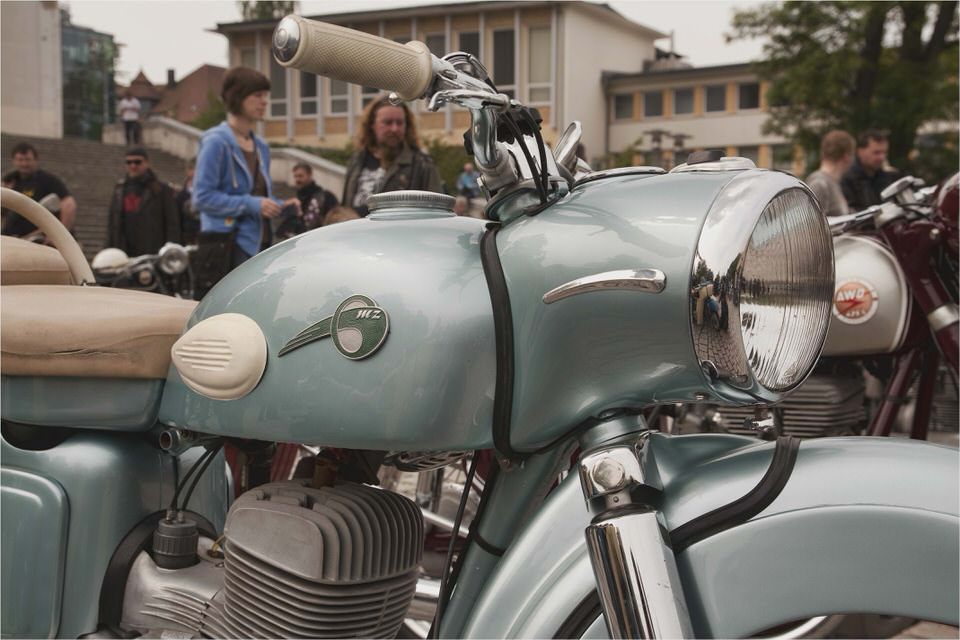
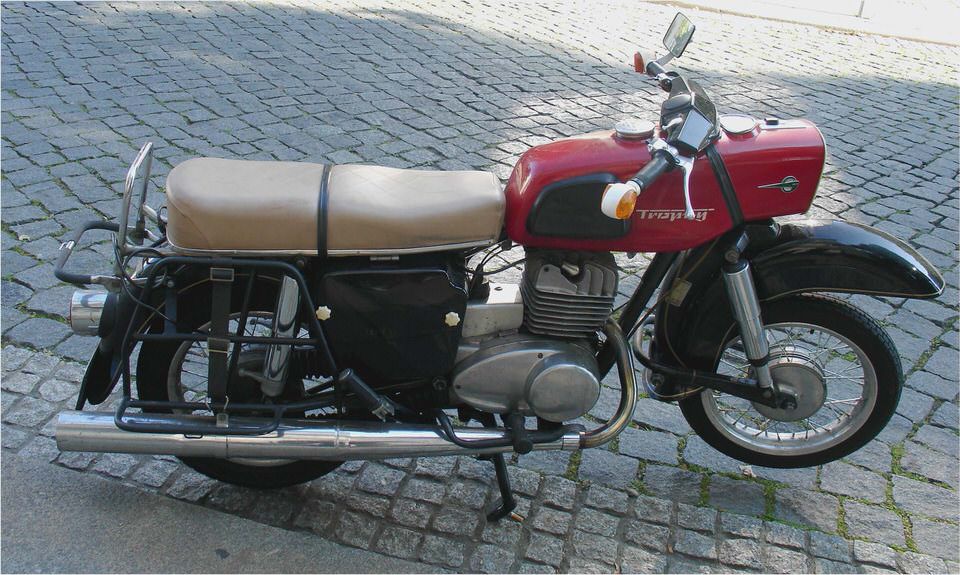
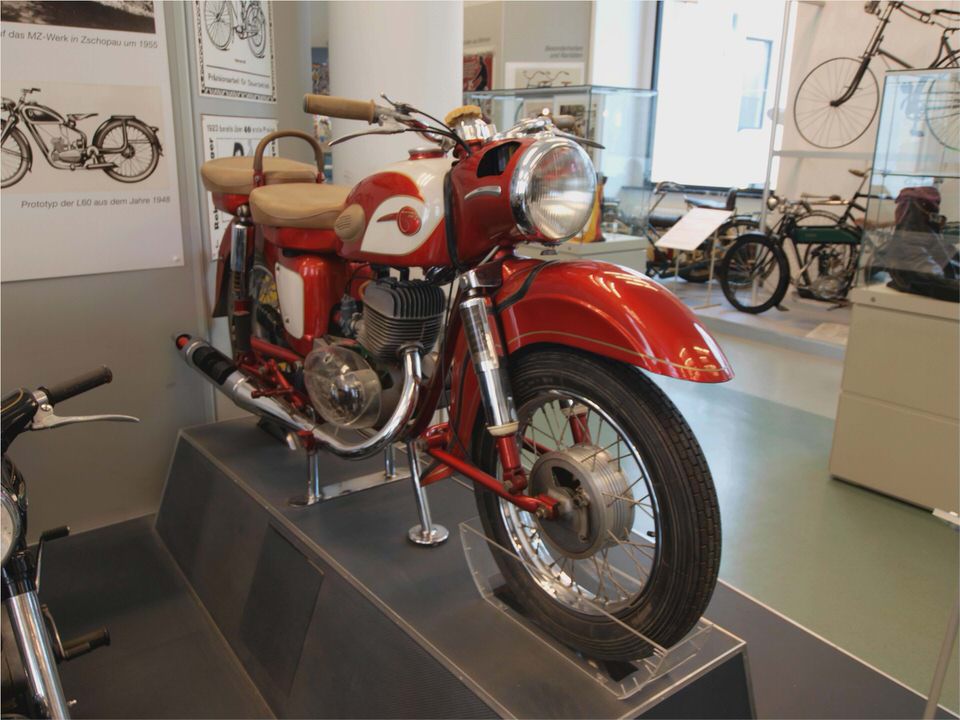
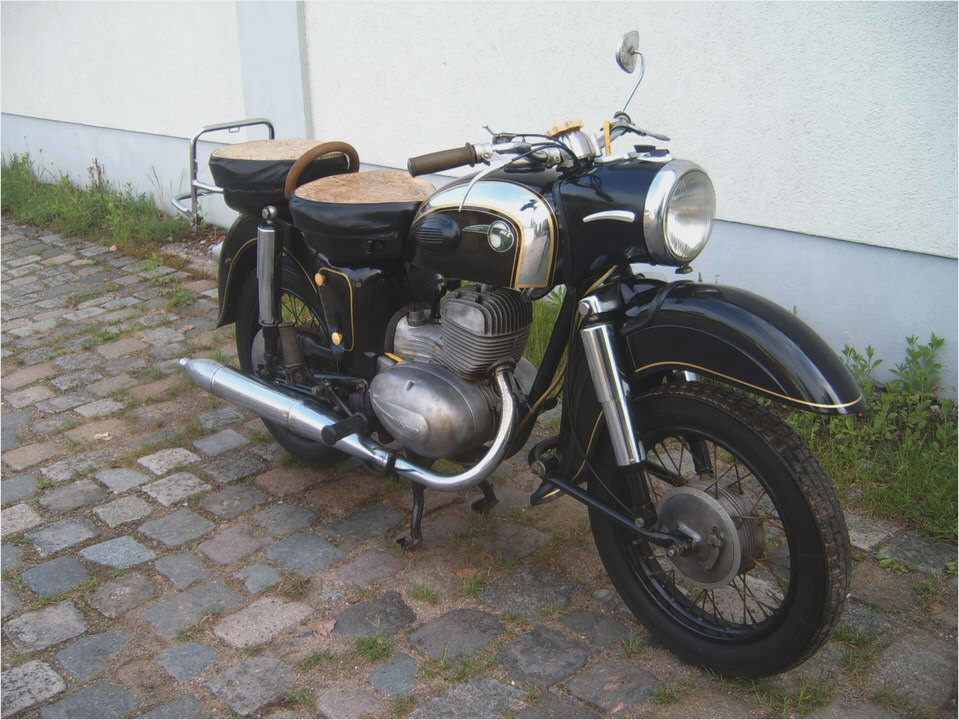

- European
- IFA BK 350 1956
- 2005 MZ Moskito 125R – Used 2005 Moskito 125 R at Motorcyclist Magazine
- MZ 125 SM
- MZ Notes – Philadelphia Riders wiki
